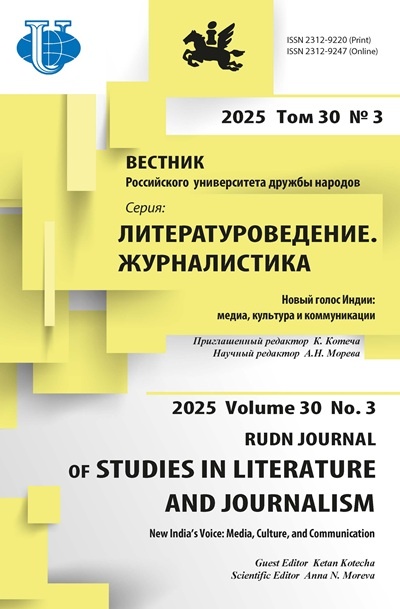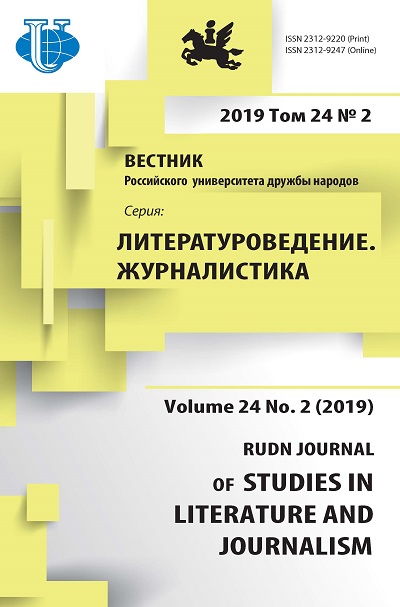Христианские мотивы в рассказе о народном ополчении 1611-1612 гг. в «Новом летописце»
- Авторы: Туфанова О.А.1
-
Учреждения:
- Институт мировой литературы имени А.М. Горького Российской академии наук
- Выпуск: Том 24, № 2 (2019)
- Страницы: 171-178
- Раздел: Литературоведение
- URL: https://journals.rudn.ru/literary-criticism/article/view/21725
- DOI: https://doi.org/10.22363/2312-9220-2019-24-2-171-178
- ID: 21725
Цитировать
Полный текст
Аннотация
Рассказ о народном ополчении 1611-1612 гг. в составе Нового летописца (1630) пронизывает идея очищения Московского государства, тесно связанная с идеей защиты истинной православной веры. Специфика рассказа о событиях 1611-1612 гг., наблюдаемая в Новом летописце, нашедшая выражение в сочетании мотивов, отражающих реальные действия по организации ополчения, и мотивов упования на Божью помощь и помощи Бога и чудотворцев свидетельствует о том, что сравнительно недавнее прошлое вполне сознательно превращается автором в конструируемый в определенной системе текст, в котором все элементы подчинены двум главным идеям. Не случайно и в личностях организаторов ополчения 1611-1612 гг. автор Нового летописца подчеркивает исключительно качества, характеризующие их как людей, глубоко верующих и поступающих в непростых событиях Смутного времени в соответствии с основами и правилами православной культуры. В целом Новый летописец отразил в рассказе о событиях 1611-1612 гг. утвердившуюся к 30-м гг. XVII в. трактовку событий, превратив историю народного ополчения в символический «знак»: победа оказалась возможна благодаря «вразумлению» людей, возвращению «падшего народа» к основам добропорядочного православного поведения, которое и было освящено помощью Бога и чудотворцев.
Об авторах
Ольга Александровна Туфанова
Институт мировой литературы имени А.М. Горького Российской академии наук
Автор, ответственный за переписку.
Email: tufoa@mail.ru
кандидат филологических наук, старший научный сотрудник Института мировой литературы имени А.М. Горького Российской академии наук
Российская Федерация, 121069, Москва, ул. Поварская, 25АСписок литературы
- Адрианова-Перетц В.П. «Смутное время» в изображении литературных памятников 1612- 1630 гг. // История русской литературы. Т. 2. Ч. 2: Литература 1590-1690 гг. / под ред. А.С. Орлова, В.П. Адриановой-Перетц, Н.К. Гудзия. М.; Л.: АН СССР, 1948. С. 45-77.
- Вовина В.Г. Новый летописец и спорные вопросы изучения позднего русского летописания // Отечественная история. М., 1992. № 5. С. 117-130.
- Демин А.С. Древнерусская литература как литература (О манерах повествования и изображения) / отв. ред. В.П. Гребенюк. М.: Языки славянской культуры, 2015. 488 с.
- Из Хронографа 1617 года // Памятники литературы Древней Руси: конец XVI - начало XVII веков / вступит. ст. Д. Лихачева; сост. и общ. ред. Л. Дмитриева, Д. Лихачева. М.: Худож. лит., 1987. С. 318-357.
- Кусков В.В. История древнерусской литературы. 5-е изд., испр. и доп. М.: Высшая школа, 1989. 304 с.
- Лурье Я.С. Общерусские летописи XIV-XV вв. Л.: Наука, 1976. 283 с.
- Новый летописец, составленный в царствование Михаила Федоровича, издан по списку князя Оболенского. М.: В Университетской тип., 1855. 190 c.
- Солодкин Я.Г. Летописец Новый // Словарь книжников и книжности Древней Руси. Вып. 3 (XVII в.). Ч. 2 (И-О). СПб.: Изд-во «Дмитрий Буланин», 1993. С. 257-263.
- Успенский Б.А. Избранные труды. Т. I: Семиотика истории. Семиотика культуры. М.: Гнозис, 1994. 432 с.
Дополнительные файлы















